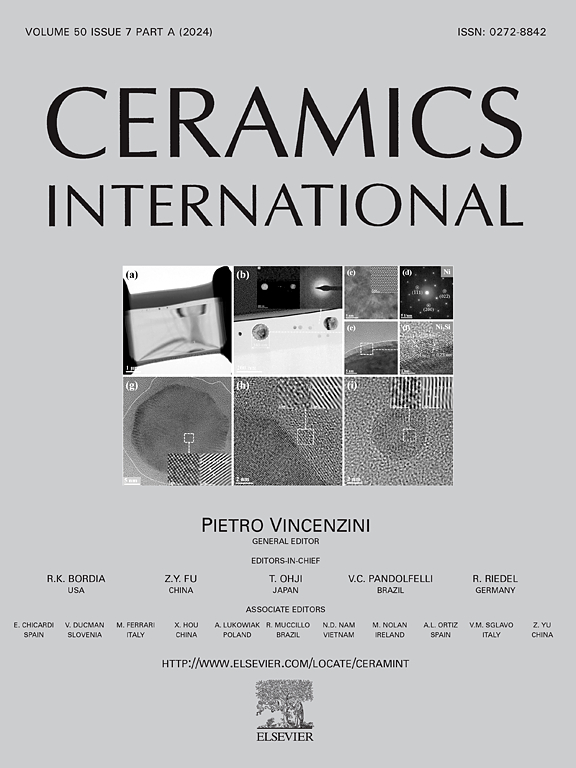Stencil additive manufacturing: An approach to fabricating porous 3D lattice alumina structures
IF 5.1
2区 材料科学
Q1 MATERIALS SCIENCE, CERAMICS
引用次数: 0
Abstract
This work employed the Stencil Additive Manufacturing (SAM) technique to fabricate α-alumina lattice structures. A ceramic slurry system based on Pluronic F-127 hydrogel was formulated to carry nano-sized α-alumina ceramic particles, achieving a solid loading of 37 vol%. The slurry exhibited non-Newtonian behaviour, making it suitable for stencil printing applications. Rheological characterisation revealed an elastic modulus of 19,600 kPa and a storage modulus of 996 kPa. Flow tests were successfully fitted to the Herschel-Bulkley model, yielding at 213.38 Pa, a flow index of 0.21, and a consistency index of 4259.24 Pa s, confirming the slurry's shear-thinning behaviour, an essential property for SAM. Stencil printing of ceramic hydrogel layers, followed by controlled drying and sintering at 1550 °C, resulted in the successful fabrication of rigid α-alumina ceramic parts. Post-sintering analysis demonstrated that crack-free specimens with heights up to 5.25 mm, maximum warping of 10 %, and 94–98 % density were achieved. The study highlights the potential of SAM for the additive manufacturing of ceramics, presenting a novel approach to fabricating complex ceramic structures. While the process shows promise, limitations such as channel closure during deposition and warping during drying must be addressed to further improve shape fidelity and accuracy. This research opens avenues for the future development of stencil-based additive manufacturing in ceramic production, which shows promise as a viable pathway to the mass manufacturing of parts.
模板增材制造:一种制造多孔三维点阵氧化铝结构的方法
本研究采用模板增材制造(SAM)技术制备α-氧化铝晶格结构。制备了一种基于Pluronic F-127水凝胶的陶瓷浆料体系,用于携带纳米级α-氧化铝陶瓷颗粒,固体负载达到37 vol%。浆料表现出非牛顿行为,使其适合于模板印刷应用。流变学表征显示弹性模量为19,600 kPa,存储模量为996 kPa。流动试验成功地拟合了Herschel-Bulkley模型,屈服于213.38 Pa,流动指数为0.21,稠度指数为4259.24 Pa s,证实了浆料的剪切变薄行为,这是SAM的基本特性。陶瓷水凝胶层的模板打印,然后在1550℃下控制干燥和烧结,成功地制造了刚性α-氧化铝陶瓷部件。烧结后分析表明,试样高度可达5.25 mm,最大翘曲率为10%,密度为94 - 98%。该研究强调了SAM在陶瓷增材制造方面的潜力,提出了一种制造复杂陶瓷结构的新方法。虽然该工艺显示出前景,但必须解决沉积过程中的通道关闭和干燥过程中的翘曲等限制,以进一步提高形状保真度和精度。这项研究为陶瓷生产中基于模板的增材制造的未来发展开辟了道路,它有望成为大规模制造零件的可行途径。
本文章由计算机程序翻译,如有差异,请以英文原文为准。
求助全文
约1分钟内获得全文
求助全文
来源期刊

Ceramics International
工程技术-材料科学:硅酸盐
CiteScore
9.40
自引率
15.40%
发文量
4558
审稿时长
25 days
期刊介绍:
Ceramics International covers the science of advanced ceramic materials. The journal encourages contributions that demonstrate how an understanding of the basic chemical and physical phenomena may direct materials design and stimulate ideas for new or improved processing techniques, in order to obtain materials with desired structural features and properties.
Ceramics International covers oxide and non-oxide ceramics, functional glasses, glass ceramics, amorphous inorganic non-metallic materials (and their combinations with metal and organic materials), in the form of particulates, dense or porous bodies, thin/thick films and laminated, graded and composite structures. Process related topics such as ceramic-ceramic joints or joining ceramics with dissimilar materials, as well as surface finishing and conditioning are also covered. Besides traditional processing techniques, manufacturing routes of interest include innovative procedures benefiting from externally applied stresses, electromagnetic fields and energetic beams, as well as top-down and self-assembly nanotechnology approaches. In addition, the journal welcomes submissions on bio-inspired and bio-enabled materials designs, experimentally validated multi scale modelling and simulation for materials design, and the use of the most advanced chemical and physical characterization techniques of structure, properties and behaviour.
Technologically relevant low-dimensional systems are a particular focus of Ceramics International. These include 0, 1 and 2-D nanomaterials (also covering CNTs, graphene and related materials, and diamond-like carbons), their nanocomposites, as well as nano-hybrids and hierarchical multifunctional nanostructures that might integrate molecular, biological and electronic components.
 求助内容:
求助内容: 应助结果提醒方式:
应助结果提醒方式:


